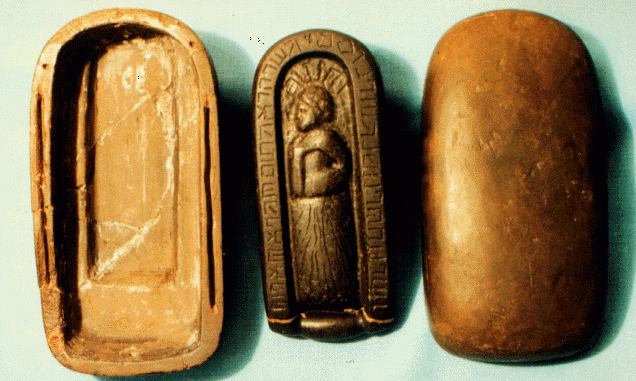
This is a term that gets tossed around among archaeologists and academics, particularly when they’re being critical of the many nonsense claims of sensationalists like Brien Foerster, Frank Joseph, and their ilk.
Essentially, the claims are something along the lines of:
1) “These elongated skulls can’t possibly be just the result of head-shaping, DNA tests show [insert non-native source].”
2) “These stones are too precisely cut and laid for natives to have done this, therefore [insert non-native source].”
3) “Here are some Hebrew artifacts therefore the Lost Tribe of Israel is responsible for mounds in North America.”
And so on…
The claims above are modern-day examples of hyper-diffusionist ideas. The first two deal with Peruvian indigenous peoples who engaged in a practice of head-shaping that resulted with intentionally deformed skulls that have an “alien appearance.” The practice, while bizarre to modern, western eyes, is one that has modern ethnographic support to the extent that there exist photographs of people who did this. Not just skeletal remains. The second claim also frequently involves Peru (along with other cultures around the world). The notion is that the indigenous people couldn’t possibly have been smart enough or capable enough to cut and move large stones. Finally, the last example above refers to spurious artifacts, many already identified as outright fakes, which purport to show “Hebrew writing” which is meant to provide evidence that, essentially, white people are responsible for the grandiose mounds we see at places like Cahokia in Illinois or Serpent Mound in Ohio. Never mind that the writing on some of these turns out to be modern Hebrew, and none are from legitimate excavations that include careful documentation.
In a nut shell, the hyper-diffusionist position is one that is racist.
This is because it stipulates that all civilizations come from one superior civilization, where everything was already invented once before. That multiple civilizations around the world could have independently invented megalithic architecture, agriculture, writing, etc. is considered impossible by the diffusionist.
The roots of diffusionist thinking come from the 19th and early 20th century as early anthropologists and archaeologists tried to reason out how civilizations came to be. It’s much easier to forgive these early scientists on their quest for knowledge and understanding than it is their modern psuedoscientific counterparts. This is because since the 19th century, much data has been gathered through the archaeological record and ethnographic data. And it should be noted that cultural diffusion through trade and contact between neighbors isn’t what’s being criticized here. That sort of small-scale diffusion is shown in the archaeological and ethnographic records, but it’s nearly always bi-directional.
The hyper-diffusionist insists that invention is unidirectional. That human beings are generally unimaginative and not willing to change independently. Friedrich Ratzel, in his Anthropogeographie (1882) and The History of Mankind (1885) wrote that “ethnologists must beware thinking that even the simplest of inventions were likely to have been made more than once, let alone repeatedly.” He considered technological inventions like the blowpipe and the bow and arrow to have been invented in once place then “diffused” to other cultures wherever these could be found in the world. He was certain they could all be traced back to a single source for each.
And Ratzel influenced Franz Boas, who introduced the concept of diffusion to America. Boas thought the only way to understand the past was to “determine the diffusionary episodes.”
Early 20th century diffusionists like Grafton Elliot Smith thought that all culture originated from Egypt and that the Maya, for instance, were cut off from their Egyptian roots after they were sent to the New World in search of resources. Other diffusionists of his time, such as Lord Raylan, thought the source of all civilization was Mesopotamia. He thought most human beings were naturally primitive and would quickly revert to “savagery,” given the opportunity, and “savages never invent anything.”
The archaeological records of their world have long since changed this way of thinking and we now understand and accept that technologies can be independently arrived at.. Atlatls, pottery, clothing, and agriculture are among the many, many technological advances that were invented over and over again all over the world at different times and places.
Today’s hyperdiffusionists are not nearly as easily forgiven. They are willfully ignorant and grossly racist. Though they don’t say it directly, the message is still the same: “white people did it, not savages.”
Or worse. The message is “aliens did it, not primitive humans.”
Further Reading
Feder, Kenneth L. (2014). Frauds, Myths, and Mysteries: Science and Pseudoscience in Archaeology, 8th Edition. New York: McGraw-Hill.
Lepper, Bradley T.; Kenneth L. Feder; Terry A. Barnhart; Deborah A. Bolnick (2011). “Civilizations Lost and Found: Fabricating History, Part 2: False Messages in Stone.” Skeptical Inquirer, 35(6)
Trigger, Bruce (2008). A History of Archaeological Thought. Cambridge: Cambridge University Press.
Leave a Reply
You must be logged in to post a comment.